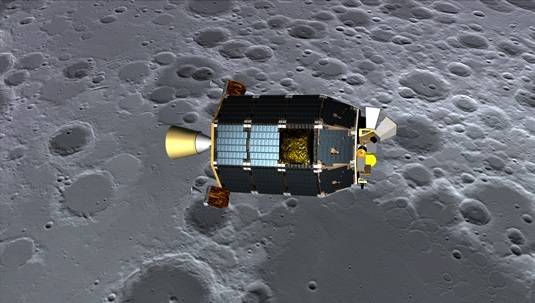Moon probe LADEE crashes into the moon at 3600 mph
Posted by: Timothy Weaver on 04/19/2014 09:32 AM
[
 Comments
]
Comments
]
The Lunar Atmosphere and Dust Environment Explorer (LADEE) spacecraft crashed into the moon as expected between 9:30pm and 10:22pm PDT on Thursday.

"There's nothing gentle about impact at these speeds. It’s just a question of whether LADEE made a localized craterlet on a hillside or scattered debris across a flat area. It will be interesting to see what kind of feature LADEE has created."
Its mission was two-fold: it measured the level of dust particles suspended in the tenuous lunar atmosphere and tested out NASA's latest space broadband system.
The LADEE mission had a total cost of $275m. That figure is near the cost of two F-35 fighter aircraft. But it showed that the concept of a modular system was a cost saving. the design has been proven and NASA expects to be able to build the next modular probe for between $80m and $100m (at least a 20 per cent saving) and the costs would fall to between $60m and $80m for the subsequent probe.
If you recall out initial report of the mission, NASA was holding a contest to see who could guess the date and time of the impact. Over 5,900 people sent in their best guesses. NASA has said it looks like 500 people may have gotten the right answer and will be announcing the results in a day or two. Those that are closest will receive a certificate from NASA.

"There's nothing gentle about impact at these speeds. It’s just a question of whether LADEE made a localized craterlet on a hillside or scattered debris across a flat area. It will be interesting to see what kind of feature LADEE has created."
Its mission was two-fold: it measured the level of dust particles suspended in the tenuous lunar atmosphere and tested out NASA's latest space broadband system.
The LADEE mission had a total cost of $275m. That figure is near the cost of two F-35 fighter aircraft. But it showed that the concept of a modular system was a cost saving. the design has been proven and NASA expects to be able to build the next modular probe for between $80m and $100m (at least a 20 per cent saving) and the costs would fall to between $60m and $80m for the subsequent probe.
If you recall out initial report of the mission, NASA was holding a contest to see who could guess the date and time of the impact. Over 5,900 people sent in their best guesses. NASA has said it looks like 500 people may have gotten the right answer and will be announcing the results in a day or two. Those that are closest will receive a certificate from NASA.
Comments






